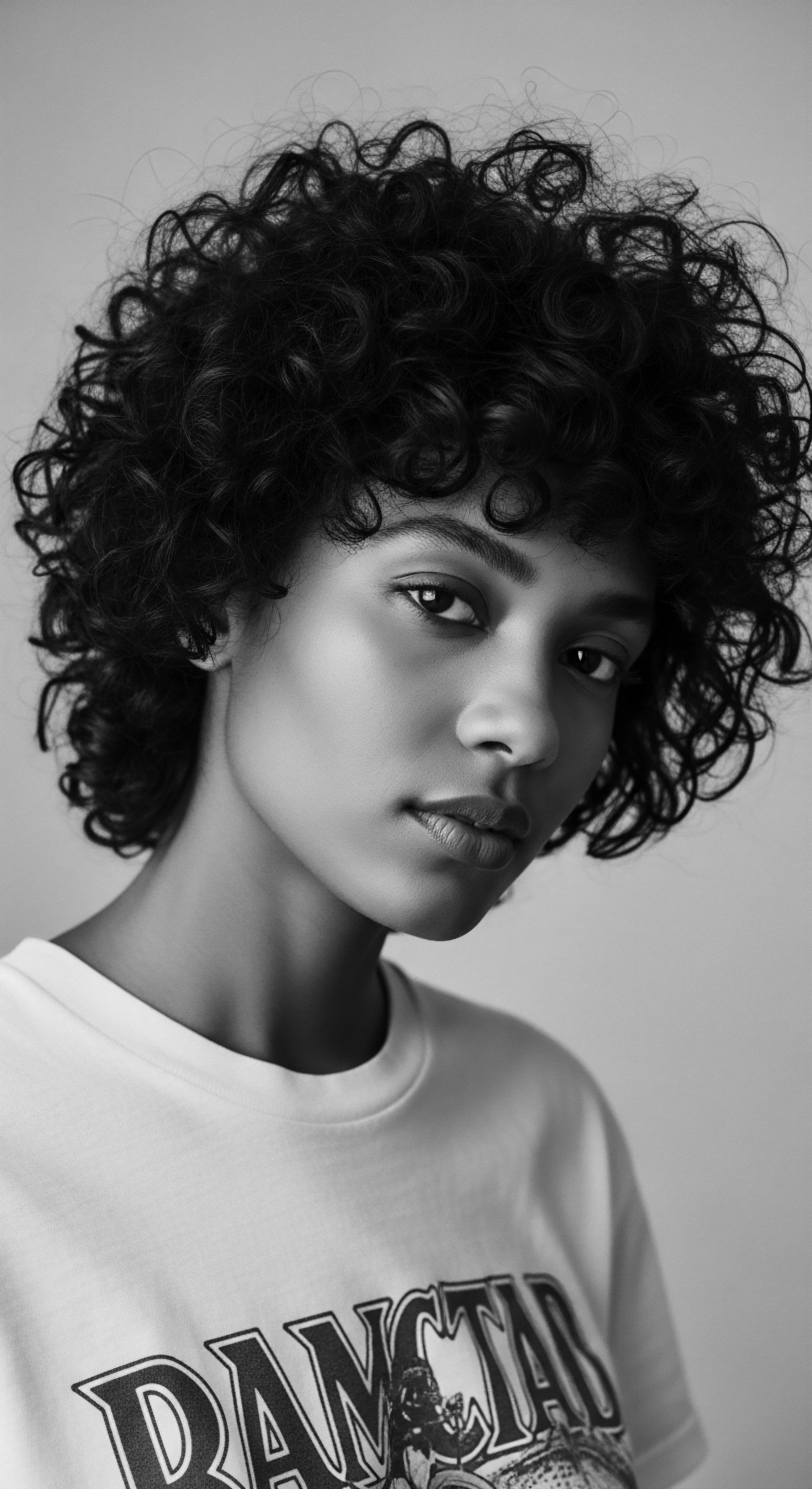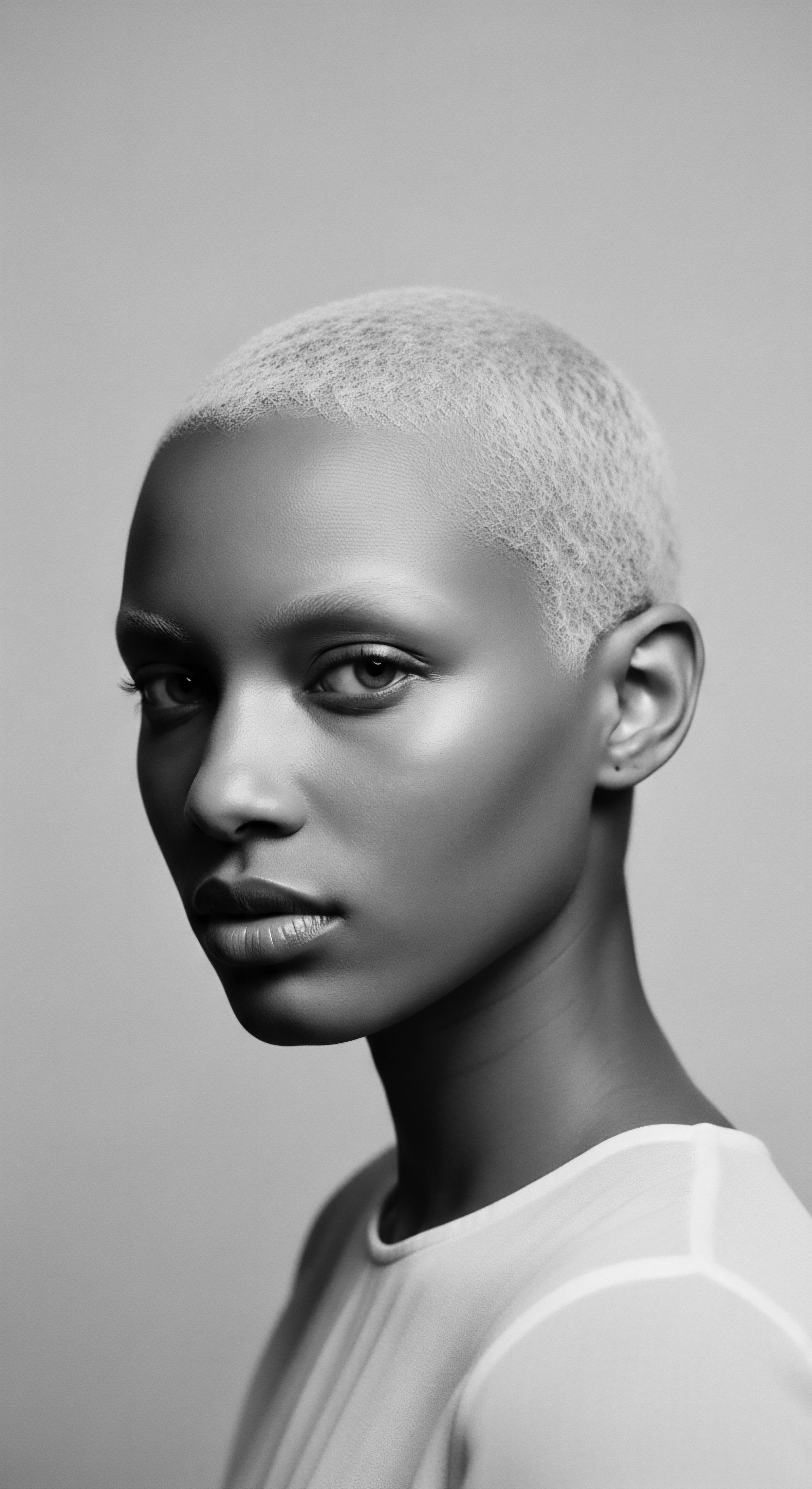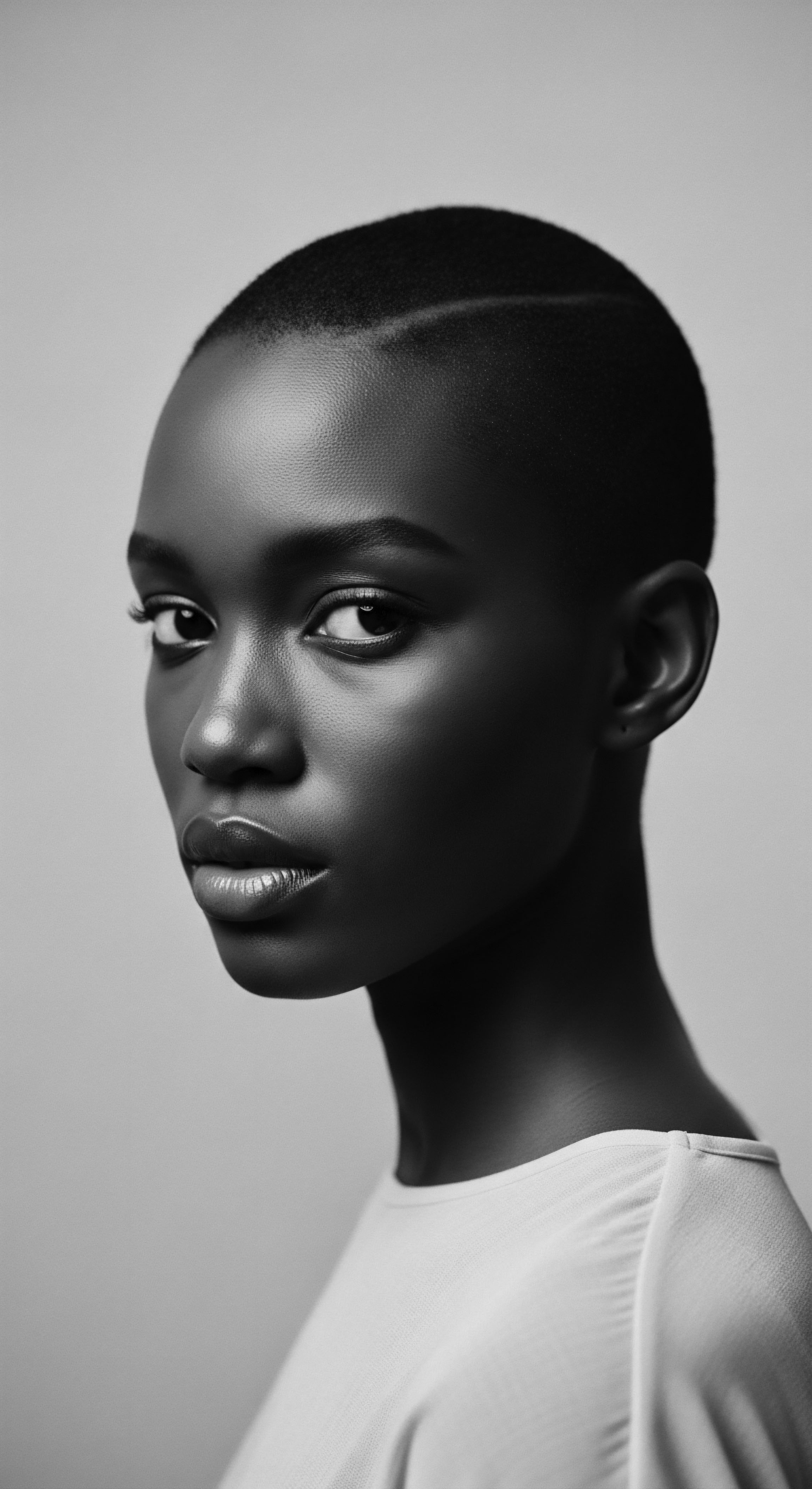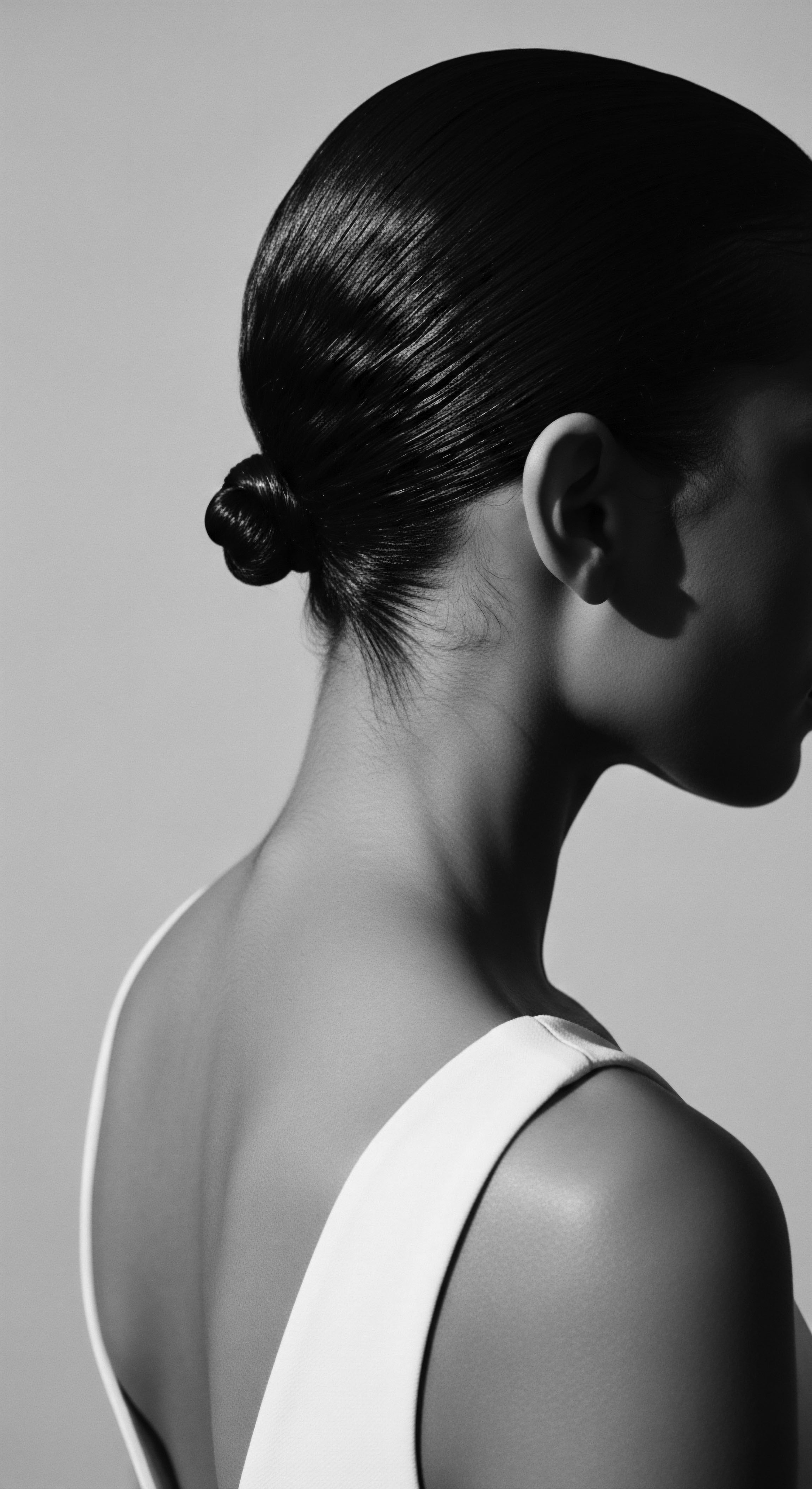
Roots
When the light fades and the world settles into its nightly hush, a quiet wisdom descends. For generations uncounted, across lands warmed by sun and cooled by ancient winds, our ancestors understood something profound about rest ❉ it was not merely a pause, but a time of replenishment for every part of being, including the strands that crowned their heads. How did historical cultures protect textured hair during this sacred period of rest?
The answer resonates with a reverence for well-being, an understanding of elemental biology, and a deeply inherited appreciation for the unique characteristics of coily, kinky, and wavy hair. This isn’t a story of modern innovation; it is a profound echo from the source, a whispered lesson from collective heritage that still shapes our choices today.

The Hair’s Intrinsic Nature
To truly grasp the ancestral practices of rest, one must first comprehend the very essence of textured hair. Unlike its straighter counterparts, coily and kinky hair possesses an elliptical cross-section, a distinct helical shape, and an uneven distribution of cuticle scales. This architecture, while wonderfully resilient and expressive, also presents specific needs. The natural twists and turns create points of vulnerability where the cuticle layer can lift, leading to moisture loss and increased friction.
Understanding these biological truths informs why protection during sleep was not a luxury but a necessity for our forebears. They instinctively recognized that their hair, in its unadorned state, could easily tangle, snag, and lose precious hydration against abrasive surfaces. This intimate knowledge of hair’s physics, gleaned through centuries of observation, laid the groundwork for the protective measures that became customary practice.
Ancestral understanding of textured hair’s unique structure guided nighttime protection as a fundamental act of care.

Ancestral Understanding of Form and Function
Long before microscopes revealed the intricate details of a hair strand, communities recognized the diverse forms of human hair. Within African societies and throughout the diaspora, textured hair was not viewed as uniform. It was seen in its myriad patterns—from broad waves to tightly packed coils, each with its own qualities and needs. This empirical understanding, passed down through oral traditions and hands-on care, led to the development of tailored resting strategies.
The very language used to describe these hair types often carried cultural significance, reflecting familial lineage or tribal affiliation. For instance, in many West African cultures, the complexity of a hairstyle could signal social status, marital standing, or even a person’s emotional state, making its preservation, especially through the night, a matter of considerable importance.
The hair’s growth cycle, too, was implicitly understood. While not articulated in modern scientific terms, the concept of hair health and its cycles was tied to overall vitality and diet. Traditional healers and caregivers observed how environmental factors and nutrition affected hair resilience. This holistic viewpoint meant that protecting hair during rest was part of a larger wellness system, ensuring the hair remained strong and vibrant through its natural life cycle.

Early Protective Materials and Their Purpose
What materials did historical cultures turn to when seeking to shield their hair as the day concluded? Across continents, the answer often involved smooth, low-friction fabrics and natural elements. Silk, for example, has a global heritage. In ancient China, its use in hair wraps was common among women to protect styles and denote status.
Similarly, in Japan, the “kazashi” silk wrap helped Geishas maintain intricate hairdos while sleeping. Middle Eastern cultures also employed silk scarves, often referred to as “hijabs” in the Arabian Peninsula, which provided both religious covering and practical protection against sun and sand, keeping hair smooth.
While European women in the mid-1800s utilized bonnets to keep warm and symbolize high society, the protective utility of head coverings held a different, yet equally vital, significance in African and diasporic communities. Headwraps, known as “dukus” in Ghana or “doeks” in Namibia and South Africa, were traditional attire for centuries, reflecting wealth, ethnicity, and marital status. Beyond their symbolic weight, these coverings had a practical function ❉ safeguarding hair from environmental elements like dust and sun, and, crucially, from friction during sleep.
- Plant Fibers ❉ Early head coverings were often crafted from readily available natural fibers.
- Smooth Fabrics ❉ Materials like finely woven cotton or early forms of silk (where accessible) minimized abrasion.
- Animal Skins ❉ In some colder climates, softened animal skins or furs might have served a protective, insulating purpose.

The Foundation of Nighttime Care
The simplest, yet most enduring, method of nighttime hair protection involved minimal manipulation and strategic positioning. For cultures with long, textured hair, braiding was a ubiquitous technique. A single braid, or multiple smaller braids, served to contain the hair, prevent tangles, and reduce friction against sleeping surfaces.
This practice not only preserved length but also maintained moisture and minimized breakage. The act of braiding itself was often a communal activity, a time for storytelling and intergenerational exchange, further embedding hair care into the fabric of daily life and heritage.
Beyond braids, simple wrapping techniques with soft cloths also emerged. These wraps acted as a barrier between the hair and rough sleeping surfaces, such as straw mats or coarse bedding. The intention was always the same ❉ to reduce the mechanical stress on individual hair strands and retain the hair’s natural moisture. This elemental understanding of protection, born from intimate knowledge of textured hair, represents the earliest stratum of heritage in sleep care.

Ritual
The transition from day to night, from active life to restorative sleep, was not an abrupt halt for historical cultures but a nuanced continuum. How did historical cultures protect textured hair during rest? The answer lies in the development of deliberate, often sacred, rituals that extended beyond mere practicalities.
These were not simply actions; they were expressions of care, continuity, and cultural identity. The practices surrounding nighttime hair care deepened, becoming intertwined with ancestral wisdom and the community’s collective understanding of beauty, health, and spiritual well-being.

From Practice to Sacred Tradition
The regular, intentional acts of preparing textured hair for rest evolved into rituals imbued with significance. These practices were often communal, especially for women, offering moments of bonding and the sharing of generational knowledge. The communal aspect reinforced the importance of hair care as a shared cultural responsibility. Consider the ancestral African context, where headwraps were not just a fashion accessory but had cultural and spiritual meaning.
They signified status, emotion, and religious affiliation. The use of these wraps, or similar coverings, at night became a logical extension of their daytime purpose, preserving the hair that held such profound meaning.
The material chosen for these coverings held importance. While silk is often highlighted in modern discourse for its low-friction properties, traditional African communities often utilized various plant-based textiles, carefully prepared and softened to achieve similar protective effects. For instance, finely woven cotton or other natural fibers, perhaps treated with plant oils, could provide a smoother surface than raw bedding. This foresight ensured that hair, which had been intricately styled or diligently maintained throughout the day, would remain protected through the night, minimizing tangles and preserving moisture.

The Anatomy of a Nighttime Regime in History
A historical nighttime hair regimen for textured hair involved several steps, each contributing to its preservation.
- Detangling ❉ Even without modern combs, careful finger detangling or the use of wide-toothed tools crafted from wood or bone would have been a precursor to sleep preparation. This helped to undo the day’s tangles and prevent them from worsening overnight.
- Moisture Application ❉ The application of natural oils and butters was a central component. Shea butter, coconut oil, argan oil, and various plant-based infusions served to seal in moisture, add pliability, and provide a protective barrier. These substances countered the drying effects of environment and sleeping surfaces.
- Protective Styling ❉ Braiding remained paramount. Single large braids, plaits, or cornrows were common. These styles not only contained the hair but also reduced the surface area exposed to friction. The act of braiding itself could be a meditative, calming evening activity.
- Head Covering ❉ The final layer of protection often involved headwraps, bonnets, or nightcaps. These coverings, frequently made from soft, absorbent, or smooth materials, acted as a physical shield against rough bedding.
In many indigenous communities, the care of hair was interwoven with spiritual beliefs. Long, uncut hair often symbolized wisdom and a connection to nature. The act of protecting it during rest would therefore have held spiritual weight, a quiet acknowledgement of its sacredness.
Nighttime hair rituals in historical cultures transcended simple care, becoming acts of cultural continuity and self-reverence.

The Bonnet and Its Heritage ❉ A Case Study in Resilience
The hair bonnet, or variations of it, stands as a profound example of how cultural practices safeguarded textured hair during rest, especially for Black women and mixed-race communities. While European bonnets served warmth and fashion, the function of head coverings in African and diasporic cultures held deeper layers of meaning and necessity.
Headwraps and bonnets were a traditional part of African attire for centuries, with varied names like “dukus” and “doeks.” These coverings reflected social standing, marital status, and even emotional states. The knowledge of preserving hair with these wraps was deeply ingrained. During enslavement in the Americas, however, this practice was tragically co-opted.
Headwraps were forcibly imposed as a marker of subjugation, stripping Black women of their cultural expression. Laws were enacted making it illegal for Black women to be in public without hair coverings.
Yet, in an astounding act of resilience and defiance, Black women reclaimed the headwrap and bonnet. They transformed symbols of oppression into emblems of resistance, cultural expression, and dignity. They chose beautiful fabrics and adorned them, using the folds to even communicate coded messages among themselves that enslavers could not understand. This reclamation was central to protecting not only their hair but their spirit.
As Ayana Byrd and Lori Tharps recount in Hair Story ❉ Untangling the Roots of Black Hair in America (Byrd & Tharps, 2001), enslaved women would braid rice seeds into their hair as a means of survival, demonstrating the deep connection between hair and life itself. The bonnets they wore at night preserved these protective styles, reducing breakage and maintaining moisture, which was particularly important given the limited access to nourishing products. This daily, nightly act became a quiet, yet powerful, assertion of agency and self-care in the face of profound adversity. The legacy of the bonnet therefore speaks volumes about the determination to protect textured hair, and the heritage it represents, even under the harshest conditions.
| Historical Period/Culture Ancient Africa/Pre-Colonial |
| Common Protective Materials Plant-based textiles, treated fibers, smooth animal skins, natural oils |
| Purpose and Heritage Connection Preservation of intricate styles; moisture retention; social/spiritual symbolism. The practice rooted in practical hair health and cultural expression. |
| Historical Period/Culture Ancient East Asia (China, Japan, Korea) |
| Common Protective Materials Silk, fine linens |
| Purpose and Heritage Connection Maintaining elaborate updos and preventing tangling; indicating social status. Silk's luxurious feel and anti-friction properties were prized. |
| Historical Period/Culture African Diaspora (Enslavement Era onwards) |
| Common Protective Materials Cotton, then later satin/silk bonnets and headwraps |
| Purpose and Heritage Connection Crucial for preserving moisture in hair prone to dryness; retaining intricate braids/twists; became a symbol of resistance and cultural preservation amidst oppression. |
| Historical Period/Culture Ancient India (Ayurvedic practices) |
| Common Protective Materials Silk scarves, natural oils (sesame, Brahmi) |
| Purpose and Heritage Connection Protection from environmental elements (dust, sun); friction reduction; part of holistic wellness practices for hair and scalp health. |
| Historical Period/Culture The enduring wisdom of choosing materials that minimize friction and preserve moisture spans centuries and diverse cultures, reflecting a shared ancestral understanding of hair health. |

Understanding Hair’s Vulnerability at Rest
From a scientific perspective, the historical practices around protecting textured hair during rest are remarkably sound. Textured hair is particularly susceptible to mechanical stress, which occurs when hair rubs against surfaces like cotton pillowcases. The natural coil patterns cause hair strands to interlock, leading to tangles, breakage, and frizz. Cotton, with its absorbent and relatively rough fibers, draws moisture from the hair, leaving it dry and more fragile.
By wrapping hair in smooth materials or containing it in protective styles, historical cultures effectively created a buffer against these detrimental forces. This reduced friction, minimizing the mechanical damage that could otherwise lead to split ends and breakage. Furthermore, by covering the hair, they helped to trap natural oils and applied treatments, thereby preserving essential moisture. This intuitive understanding of hair’s needs, centuries before modern cosmetic science, underscores the deep intelligence embedded within ancestral practices.

Relay
The echoes of ancient practices reverberate through contemporary hair care, creating a profound relay of knowledge across generations and cultures. How did historical cultures protect textured hair during rest? The answer is not static; it is a dynamic testament to human ingenuity and resilience, continuously informing our modern approach to hair health and heritage. This segment delves into the sophisticated nuances of these inherited strategies, examining their cultural contexts and the scientific principles that validate their enduring relevance.

The Interconnectedness of Hair, Identity, and Ancestry
For communities with textured hair, particularly those of Black and mixed-race heritage, hair is rarely a mere aesthetic choice. It is a chronicle, a living archive of identity, history, and survival. The deliberate act of protecting hair during rest, therefore, carries weight beyond its physical benefits. It is a daily reaffirmation of self-worth and a quiet act of defiance against historical forces that sought to diminish Black beauty.
As explored by Byrd and Tharps (2001) in Hair Story, the complex relationship between Black Americans and their hair is deeply tied to socio-political shifts and the reclamation of cultural identity. The nightly ritual of wrapping, braiding, or covering hair connects one directly to the ancestral lineage of those who preserved their strands against immense odds.
This connection is especially poignant when considering the concept of sleep itself. Sleep is a period of vital physiological repair, impacting everything from skin rejuvenation to hair growth. Deep sleep supports blood circulation to the scalp, delivering essential nutrients that encourage stronger hair. Disruptions to sleep can contribute to hair thinning and loss.
Thus, historical practices that promoted both hair protection and restful sleep (by minimizing discomfort or breakage) were, in essence, holistic wellness strategies. The cultural significance of safeguarding hair, recognizing its contribution to overall well-being, aligned with a broader ancestral understanding of health as an interconnected system.

The Scientific Underpinnings of Ancestral Wisdom
Modern cosmetic science consistently validates the intuitive wisdom of historical hair protection methods. The key principles revolve around reducing friction, retaining moisture, and minimizing manipulation.
- Friction Reduction ❉ The smooth surface of silk or satin head coverings dramatically lessens the friction between hair and bedding materials. Unlike cotton, which has a rougher fiber and can snag delicate hair strands, silk and satin allow hair to glide, thereby preventing breakage, split ends, and frizz. This mechanical protection is critical for textured hair, whose natural coil patterns make it more susceptible to damage from rubbing.
- Moisture Retention ❉ Textured hair tends to be naturally drier due to the way its coil structure impedes the smooth travel of natural oils (sebum) down the hair shaft. Covering the hair at night, especially after applying natural oils or treatments, creates a micro-environment that helps to trap moisture. This prevents evaporation and keeps the hair hydrated, supple, and less prone to brittleness.
- Minimizing Manipulation ❉ Protective styles like braids, twists, and locs reduce the need for daily styling, which in turn limits mechanical stress on the hair. When these styles are maintained overnight with a covering, their longevity is extended, further reducing overall manipulation. This simple principle, practiced for centuries, directly contributes to length retention and strength.
An illuminating perspective emerges from the “Handbook of Cosmetic Science and Technology” (Barel, Paye, & Maibach, 2014), which, while focusing on contemporary cosmetic formulations, often echoes the fundamental challenges and solutions that textured hair has always presented. The need for lubrication, moisture retention, and mechanical protection, so central to modern hair product development, was addressed through ancestral methods centuries ago.

Variations and Adaptations Across the Diaspora
The fundamental concept of nighttime hair protection diffused and diversified as cultures interacted and populations migrated.
In the Caribbean, for example, the practices brought from Africa blended with local resources and climates. Women continued traditions of braiding and wrapping hair in headties before bed, sometimes infusing their hair with blends of indigenous plant oils. These traditions served to preserve hairstyles in humid conditions and protect against the daily wear of active lives. The headtie, or “bandana,” in many Caribbean islands, like the ‘tignon’ in Louisiana during the colonial era, also took on complex social meanings.
Though often imposed as a mark of lower status, it was subverted and repurposed as a display of creativity and cultural pride. The strategic wrapping during the day, extending to nighttime care, became a subtle yet potent act of self-possession.

Global Parallels ❉ Shared Wisdom in Hair Preservation
While the focus here rests on textured hair heritage, it’s compelling to observe parallels in hair protection across disparate cultures, highlighting a universal human recognition of hair’s vulnerability at rest.
| Cultural Context Ancient European Aristocracy |
| Common Nighttime Hair Practices Lace or silk nightcaps, elaborate pinning |
| Underlying Principle Preserving intricate formal hairstyles; protecting delicate fabrics from hair oils. |
| Cultural Context Traditional Jewish Women (Tichel) |
| Common Nighttime Hair Practices Hair fully covered with a tichel (head covering) |
| Underlying Principle Observance of religious customs to conceal hair; often tied in ways that preserve modest styles. |
| Cultural Context Indigenous American Tribes |
| Common Nighttime Hair Practices Braiding, wrapping hair in soft hides or cloths |
| Underlying Principle Honoring hair as sacred; protecting long hair from tangles and environmental elements during rest. |
| Cultural Context Modern Textured Hair Community |
| Common Nighttime Hair Practices Satin/silk bonnets, pillowcases, wraps, protective styling (braids, twists) |
| Underlying Principle Minimizing friction, retaining moisture, extending style life, reclaiming cultural heritage. |
| Cultural Context Despite diverse origins, the shared intention of reducing damage and preserving hair's condition during sleep unites these practices across human history. |
The commonality across these distinct groups reinforces the scientific understanding of hair’s needs for protection, especially when vulnerable during sleep. Whether for practical preservation, cultural identity, or spiritual adherence, the nighttime ritual of hair protection has been a constant thread through human experience. This relay of wisdom, from elemental observation to complex cultural expression, continues to shape how we care for our hair today.

Reflection
The quiet hours of night, once a time of simple slumber, reveal themselves through history as a canvas upon which cultures painted their deepest regard for textured hair. How did historical cultures protect textured hair during rest? The query leads us not merely to techniques or tools, but to a profound meditation on the enduring soul of a strand, its heritage, and its care. We find that the roots of modern practice are not simply foundations; they are living lineages, breathing stories that connect us to the ingenuity and resilience of those who came before.
To drape a silken wrap around coils, to braid strands with intention before the world sleeps, to apply balms rich with ancestral botanicals—these actions, once daily necessities, remain profound acts of self-reverence. They speak to an innate understanding of textured hair’s unique biology, a wisdom that transcended formal scientific inquiry. These practices became rituals, then heritage, passed down through whispers and hands-on guidance, adapting and persisting even through times of profound historical struggle. The enduring journey of the hair bonnet, from a symbol of subjugation to an emblem of cultural pride and self-care, stands as a testament to this unwavering spirit.
In tracing these historical paths, we witness a continuous relay of knowledge. The ancient understanding that friction and dryness are the adversaries of textured hair finds its validation in contemporary science. The ancestral impulse to protect and preserve is echoed in every satin pillowcase, every carefully tied scarf, every nightly twist-out.
This is more than maintenance; it is a conversation across time, a living archive of a heritage that celebrates every wave, curl, and coil. The legacy of protection during rest reminds us that our hair is not just fiber; it is a repository of history, a beacon of identity, and a vibrant link to the unwavering spirit of our ancestors.

References
- Byrd, A. D. & Tharps, L. L. (2001). Hair Story ❉ Untangling the Roots of Black Hair in America. St. Martin’s Press.
- Barel, A. O. Paye, M. & Maibach, H. I. (Eds.). (2014). Handbook of Cosmetic Science and Technology (4th ed.). CRC Press.
- Sagay, E. (1983). African Hairstyles ❉ Styles of Yesterday and Today. Heinemann Educational Books.
- Corson, R. (1980). Fashions in Hair ❉ The First Five Thousand Years. Peter Owen.
- Paludi, M. H. (2008). The Social History of Hair ❉ Culture, Fashion, and Identity. Praeger.
- Smith, J. D. B. (2007). Afro-textured Hair ❉ A Study of Its Physical and Mechanical Properties. Xlibris Corporation.
- Zviak, C. & Robin, J. (1998). The Science of Hair Care. CRC Press.
